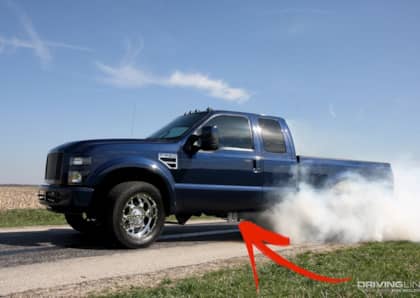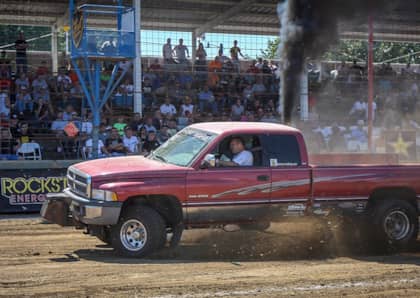Red Diesel—What Is It?
It’s known as red dye, red fuel, farm fuel, off-road diesel and even cherry juice, and it’s the same ultra low sulfur diesel (ULSD) you’ll find at your local filling station. The only difference is that it’s been treated to an oil-soluble red dye for identification purposes. What purposes? Primarily taxes. Red diesel fuel is taxed significantly lower than regular diesel fuel (i.e. clear fuel, or non-dyed fuel) because it isn’t intended for on-highway use. State and local taxes are factored into the price you pay for clear diesel at the pump, which is said to be allocated to the building, repair and maintenance of your state’s roadways.
The biggest questions diesel owners have about red dye is whether or not it will damage their engine and whether or not they can run it on public highways. The answer to the former is that it won’t cause any harm, provided their red fuel isn’t laced with high sulfur content and being run through a modern engine (which calls for ULSD). As for the other question: no. You cannot operate a vehicle running red-dye fuel on any public roadway. For more on how red-dye diesel is made, why it’s cheaper than clear and which circumstances allow you to run it, legally, keep scrolling.
Red Fuel—What Is It?

The primary purpose of red dye diesel fuel is for identification. The red dye indicates that the fuel isn’t taxed as highly, at the local (state) and/or federal level, as road-going (clear) fuel is. Red diesel is heavily rebated, which is another way of saying it is taxed significantly less than the fuel you find at your local filling station. The red dye itself is a synthetic azo dye called Solvent Red 26, and it’s the standard dye mandated by the U.S. IRS to distinguish between off-road fuel and clear road fuel. Solvent Red 26 is also mandated by the EPA for use in high sulfur diesel fuel.
Red Fuel’s Legality

Because red fuel isn’t taxed as much as regular pump diesel, it cannot be used on public roadways. In short, the tax(es) you pay at the pump are intended to pay for the public highways you drive on every day. However, red dye is allowed in virtually any off-road environment. This means farm use, power generation via gen-sets, construction equipment, mining and other off-road vehicles or machinery.
Myth-Busting

There are two common misconceptions surrounding red fuel: one being that it is specially formulated and the other being that it will damage your engine’s fuel system. While some red-dyed diesel is high in sulfur (the opposite of ULSD) and could potentially cause problems in the latest common-rail systems, those instances are extremely rare. More than 99-percent of all red fuel produced for North America has the exact same chemical makeup as the clear ULSD you buy at the gas station. The only difference is the color.
Where And How You Can Get It

No special license is required to sell red dye diesel, but a seller does have to be certified to carry it. While some filling stations may have a pump dedicated to red fuel, most do not. The majority of red fuel is transported by way of a wholesale distributor who delivers it directly to your farm or jobsite for use in agriculture or construction equipment. Some wholesale fuel distributors even offer tank rental services.
Penalties For On-Road Use

Obviously, due to its tax exemptions, red fuel is illegal to run on public roadways. Penalties for doing so vary from state to state, but can be fairly harsh if you’re caught. In Arizona for example, the penalty for illegal use of red dye diesel carries a minimum fine of $1,000, or $10 per gallon of red dye diesel involved, whichever is more. Multiple offenses can result in civil penalties and even criminal charges. Detection is performed by authorities “dipping” the fuel tank, the results of which are instantaneous.
Beyond Red Dye: ULSD, LSD And High Sulfur Diesel

Most diesel engines manufactured post-2006 (the year ULSD became the national standard in the U.S.) are designed to run on ULSD. On the other side of the coin, most engines produced prior to 2006 were designed to run on LSD (low sulfur diesel). For reference, ULSD’s sulfur content is limited to 15 ppm, LSD features a limit of 500 ppm and high sulfur diesel contains more than 500 ppm. The switch to low sulfur content in the move from LSD to ULSD is said to have stripped much of the lubrication properties out of diesel fuel. However, this can be remedied with a quality fuel additive.
There’s Blue Dye, Too

Believe it or not, there is even blue dye diesel. You’ve likely never seen it because it’s typically reserved for vehicles in the federal government’s fleet here in the United States. However, across the pond in Europe many countries dye their diesel blue (among them are Estonia, France, Portugal and Spain). Jet A and Jet A-1 fuel used in aircraft is close in chemical makeup to diesel fuel, and is often dyed blue, green, red and even purple.
More From Driving Line
- Synthetic and high bio content diesel fuels are a thing, too—and the kinds of mega-horsepower engines you’ll find here are often running them.











